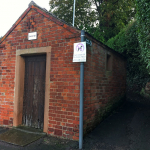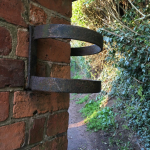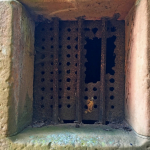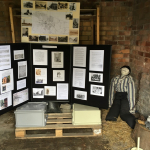The Farnsfield Lock-up
Lock-ups are historic buildings that were used for the temporary confinement of those accused of criminal acts or drunken and disorderly behaviour. This would generally be limited to a few hours or overnight until they could be brought before the local magistrate. They were in use from the 16th century and some were probably still used into the 20th century. The majority of surviving village lock-ups date from the 18th and 19th centuries when rural communities struggled to deal with thefts, drunken and disorderly behaviour, vagrancy, poaching and the stealing of livestock.
Farnsfield Lock-up
A typical village lock-up is a small purpose-built structure with a single door and a narrow-slit window or opening. They were built in many different shapes and styles; they could be round, some had a spire or dome shaped roof and many had local names; for example, round-house, blind-house, cage, guard-house, tower, watchhouse. The Southwell lock-up was called a ‘bridewell’, named after the first House of Correction founded in Bridewell, London in 1553. A lockable room attached to a pub, police station, prison, workhouse or commercial building might also function as a lock-up.
The Grade II listed Farnsfield lock-up is a relatively late example, built in 1850 ‘at the Maypole’. It was commissioned by the Parish Vestry and a 2¼d (2 penny’s and a farthing) in the pound rate was collected to help pay for the cost of its construction. It is likely that a local village bricklayer built it, using red brick with stone dressings. The door is wood with stud headed nails and a heavy sheet metal backing; there is one side window with metal bars. On the outside of the building, on the right-hand rear corner is a curved iron fixture. Inside is a single cell space with evidence of two heavy chains, one on each side wall. There is no evidence that the Farnsfield lock-up ever had another local name. After the lock-up was built the village Maypole was moved to The Green.
There is evidence of the lock-up being used identified from contemporary newspaper articles. In February 1857, a party of potters who had been drinking all day in Farnsfield, were apprehended by the local police constable for riotous behaviour. Two of them were secured in the lock-up before being taken before the magistrate at Southwell, who fined each of them 10s & 6d (10 shillings and sixpence)
In August 1876, a local man named Samuel Hunt was detained in the lock-up overnight after a violent assault on a local blacksmith. His case was heard at the Southwell Special Sessions, where he pleaded guilty and was sentenced to one month’s hard labour at Southwell House of Correction.
The lock-up has been opened on an occasional basis over the last two years for people to look inside this historic building and see small exhibitions about the local history of Farnsfield including crime, punishment and the role of the lock-up; and the social and cultural history of 18th and 19th century Farnsfield village life.
Contribution from Gill Sarre and Lesley Healy



